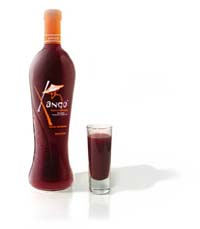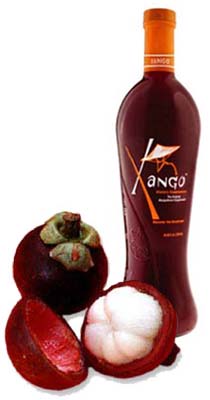|

As
featured in The New York Times and Gourmet
Magazine
 BANGKOK
- I'm a big-time mangosteen addict, which presents problems. BANGKOK
- I'm a big-time mangosteen addict, which presents problems.
The mangosteen — a tropical
fruit about the size of a tangerine, whose leathery
maroon shell surrounds moist, fragrant, snow-white segments
of ambrosial flesh — can't get a visa. Mangosteens
may not legally be imported into the United States.
They may not legally be shipped to the mainland from
Hawaii, where a few sturdy souls have lately begun to
grow them anyway.
Here in Thailand and elsewhere
in Southeast Asia, notably Vietnam and Singapore, people
buy them by the bagful for small change. In Vancouver
and other Canadian cities with big Asian populations,
you can find them at street markets and greengrocers.
In Paris, Fauchon will sell you one for a prince's if
not quite a king's ransom.
But back home in Washington,
the best I can do without jumping on a plane is the
wooden mangosteen, handsomely carved and oiled, that
sits on my desk there.
TOP
So
what, you may say. What's he getting worked up about?
He can gobble up papayas, mangoes and even rambutans
when he gets a tropical itch. In the summer, he can
eat perfectly ripe peaches, still warm from the tree,
and dark, sweet plums whose juices squirt out when a
tooth breaks through their taut skins.
Friends have accused me of craving
mangosteens because they are beyond my reach, the way
children in the old Soviet Union craved oranges. Not
guilty, say I.
No other fruit, for me, is so
thrillingly, intoxicatingly luscious, so evocative of
the exotic East, with so precise a balance of acid and
sugar, as a ripe mangosteen. I thought so when I first
tasted one half a lifetime ago, in Singapore, and I've
thought so ever since. I'd rather eat one than a hot
fudge sundae, which for a big Ohio boy is saying a lot.
"By popular acclaim,"
writes the British-born Malaysian author Desmond Tate
in "Tropical Fruit" (Tuttle Publishing, 2001),
"the mangosteen is held to be the most delectable
of all the tropical fruits, and it has been proclaimed
their queen. There is no doubt about the luxury of its
taste. It has won unstinted praise down the ages from
all who have encountered it."
I
could tell you that the flavor reminds me of litchis,
peaches and clementines, mingled in a single succulent
mouthful, but words can no more describe how mangosteens
taste than explain why I love my wife and children.
Merely typing the name makes my mouth water. Whenever
in my travels I spot a mound of those precious orbs
in a marketplace, my heart pounds.
TOP
For years, before she finally
tasted one, I drove my wife, Betsey, almost around the
bend talking about mangosteens, telling her that whatever
luxurious item we were consuming at a given moment was
no match for my forbidden fruit.
I'm not alone in my mania. My
friend Gay Bilson, one of Australia's greatest cooks,
says that the first time she cut open a mangosteen and
tasted a segment, she "burst into tears at the
sheer perfection of it, almost pushed to mawkish poetry."
Karen Caplan, president of Frieda's,
a wholesaler of specialty produce in Los Alamitos, Calif.,
said she could not believe her senses at age 16 when
her mother gave her a bite of a ripe mangosteen from
Belize."
Queen Victoria reportedly offered
a knighthood to anyone who could bring her a specimen
in edible condition. Nobody ever managed to snatch the
prize.
In her time, the problem was
spoilage. In our day and our country, it is the Mediterranean
fruit fly, which the Department of Agriculture, ever
vigilant in its protection of domestic crops, does its
best to stop at the borders of the continental United
States. Mangosteens can be infested with the dread insect,
and until recently, no safe way to assure "disinfestation,"
as the bureaucrats call it, had been found.
Yet
there are tantalizing prospects that the gates may open,
if not this year, then next year, or someday soon.
TOP
THE breakthrough, or rather the
potential for one, came last October, when the government
issued a ruling that all fruits and vegetables that
might carry fruit flies could now be irradiated for
sale in the United States.
Irradiated papayas and other
fruits from Hawaii have been sold in California for
several years. But the new ruling could open the huge
American market to growers all over the world, and could
bring mangosteens to American dinner tables at last.
Before that can happen, however,
a risk assessment must be carried out for each type
of fruit and each producing entity, according to Dr.
I. Paul Gadh, an import specialist at the Agriculture
Department's Animal and Plant Health Inspection Services
in Riverdale, Md., near Washington. He said he could
offer no prediction on when the work on mangosteens
might be completed.
Equipment to carry out irradiation,
manufactured by the SureBeam Corporation of San Diego,
is already in operation in Hawaii and Brazil, and a
system has recently been sold to Vietnam.
Mark Stephenson, a SureBeam vice
president, said that fruits (or meats, on which it is
already widely used) are briefly bombarded with a stream
of electrons similar to X-rays. The electron beams are
generated by electrical power, he said, and no nuclear
materials are used.
The
process raises the temperature of the material being
irradiated by only one degree, causing no change in
the taste or the texture. It eliminates pests and retards
spoilage by destroying harmful food-borne bacteria.
But it has generated controversy.
TOP
Although approved by the American
Medical Association, the American Dietetic Association,
the World Health Organization and other bodies, irradiation
has long been opposed by a few activist groups. The
most prominent of these is Public Citizen, founded by
Ralph Nader, which has contended that more detailed
research is needed on the long-term results of irradiation
before it can be considered safe.
"Exposing food to ionizing
radiation results in the formation of potentially carcinogenic
compounds," Wenonah Hauter, a Public Citizen official,
told a Congressional committee in 2001. She also asserted
that the process destroys crucial vitamins.
Christine M. Bruhn, director
of the Center for Consumer Research at the University
of California at Davis, dismissed such criticisms out
of hand. "There is no indication whatsoever of
any ill effects," she said, arguing that Public
Citizen's views were based on outdated and irrelevant
data.
"Any
worries about irradiation are very small," said
Michael F. Jacobson, executive director of the Center
for Science in the Public Interest, based in Washington.
"I would welcome more research, but I haven't been
exercised about this, and I'm still not."
TOP
Still, consumer resistance to
irradiated foods has been high, and some supermarkets
do not stock them. James Parker, director of the northern
Pacific region for Whole Foods, a Texas-based chain,
told The San Francisco Chronicle that he welcomed the
phase-out of methyl bromide disinfestation that irradiation
might help make possible, but would not carry irradiated
produce.
"We don't want the cure
to be worse than the disease," Mr. Parker said.
"We still don't know the long-term effects."
THE mangosteen (Garcinia mangostana)
originated, most botanists believe, in Malaysia or the
Sunda Islands of Indonesia. Fruits are borne on very
slow-growing evergreen trees with glossy, dark green
leaves and pyramid-shaped crowns. At maturity the trees,
which require high humidity and heavy rainfall, can
reach 40 feet in height and yield up to 1,000 fruits
a year.
Mangosteen trees can tolerate
no temperature below 40 degrees Fahrenheit, which restricts
their range. Outside of Southeast Asia, they have flourished
in just a few places — southern India, some islands
in the Caribbean (where they produce inferior fruit)
and Queensland, in northeastern Australia.
They have done badly in California,
worse in Florida. Commercial cultivation is in its early
stages in Hawaii, on the rainy east coast of the Big
Island, around the city of Hilo, where mangosteens are
sold in the farmers' market.
But mangosteens have been known
to American botanists for a century. In 1930, the great
plant explorer David Fairchild, who lived near Miami,
wrote as follows about the fruit:
"It
is so delicate that it melts in the mouth like ice cream.
The flavor is quite indescribably delicious. There is
nothing to mar the perfection of this fruit, unless
it be that the juice from the rind forms an indelible
stain on a white napkin. Even the seeds are partly or
wholly lacking and when present are very thin and small."
TOP
Ms. Caplan, the produce wholesaler,
said she doubted that the mangosteen would match the
kiwi fruit in rapid acceptance in the United States.
But once available, she predicted, it would gain immediate
popularity among Asian-Americans, with the remainder
of the population following along
later, perhaps in seven or eight years.
For the most part, mangosteens
are eaten out of hand. (A real fan has trouble getting
them home; they tend to disappear in the car on the
way from the market.)
In southern Thailand, around
Phuket, Thais use green mangosteens in a vegetarian
curry. In Goa, they are used in a fish curry. Like soursops,
a more fibrous fruit with a similar taste, they make
a rich, heady sorbet.
In his encyclopedic "Thai
Food" (Ten Speed Press, 2002), David Thompson includes
an enticing recipe for beef and mangosteen soup. Anyone
for mangosteen margaritas?
Lore and legend seem to follow
this fabulous fruit wherever it goes.
One Sunday morning at Bangkok's
rich Aw Taw Kaw open-air market, Bob Halliday, an American
writer and translator who has lived in Thailand for
35 years, showed me how to pick the best ones.
 "Squeeze
them," he advised, as he did just that. "They
should yield to pressure, and should have no hard spots.
The darker the color the better the taste." "Squeeze
them," he advised, as he did just that. "They
should yield to pressure, and should have no hard spots.
The darker the color the better the taste."
At
the stem end, mangosteens have four waxy sepals. At
the other, they have four to eight flat, woody lobes,
arranged in a pretty rosette. That much I had known.
What I had not known, and what Mr. Halliday told me,
is that the number of those lobes corresponds exactly
to the number of fruit segments arranged inside as exquisitely
as the jewels inside a Fabergé egg.
TOP
Dubious, I bought and then cut
open five or six mangosteens right then and there, strictly
in the spirit of scientific inquiry, of course. He was
right.
On another day, in another market,
Aun Koh, a young Singaporean photographer, explained
to me the Chinese belief that the primary forces influencing
bodily health are heat and coolness.
In this balance between yin and
yang, mangosteens supply the cool element to offset
the heat of the other most-loved Southeast Asian fruit,
the huge, spiky durian, whose foul aroma would stun
a goat. Many Asians therefore like to consume the two
fruits at the same time.
"We describe the mangosteen
as the queen of fruits," he reminded me. "We
call the durian the king."
Well, I for one have always preferred
the company of ladies.
Copyright
2003 The New York Times Company
Back
to Newsletter
ADDITIONAL
INFORMATION:
Bcome
a DIstributor Now. Here's How.
TOP

Visit
our
website
now, or call us today at 702-376-4727 to discuss the
tremendous opportunity that XanGo�
presents for you - both for your
health and your financial wellness.
Back
to top
Back
to Our Main Xango Page
|

